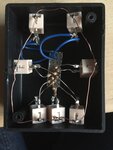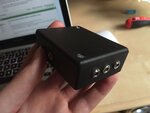tommyjay
Newbie level 4
Hey All!
I was checking out an Instructable at https://www.instructables.com/id/Altoids-Tin-18-Stereo-Mixer/ because I have some problems with my Y adaptor, so I wanted to find a better solution, and found this instructable. Right now I have one output, and two inputs, but I’m planning on adding a third device to the mix, so just in case I want to make it with 4 inputs.
Somewhere in the comments, someone mentioned to check out this link: **broken link removed** to read more about mixers, how they work, and how they should be wired. I don’t understand circuits and all the components that well, and I definitely have problems understanding all the calculations that go on between volts, watts, amps, ohms and so on. Though I have recently been introduced to the world of Arduino, and I’m loving it.
I definitely want to have a passive circuit, I don’t want to add batteries or a wall wart to the mix. I also don’t need to add volume control or faders or anything, Just want to make a little box to which I would connect my laptop, AirPort Express, and in the future my Homey ( athom.com ).. and that box would be hidden and connected to my HiFi. It’s not even about mixing sounds together, it’s just about having them all plugged in and not keep unplugging and changing the cable.
The diagram on the audio mixing website first takes the level down with resistors, and then back up with an amp… Specifically a TL072. I live in the Czech Republic, and pretty much the only place to buy parts is the store I found a Texas Instruments chip like that: https://www.gme.cz/tl072-dip8-texas-instruments-p311-013 It has two of these amplification triangles (like in the circuit diagram) which isn’t an issue, but it does have a + and -… And I guess it wouldn’t work passively. So….. basically, what I am asking is what component could I use to add to that circuit that is attached, that can amplify the signal up again, without having to add voltage to it… Basically, I want to make the same thing, without having to add external power.
audmix-f2.gif
Any chance you would know what I can use instead of that?
P.S. I understand that the ground of the audio signals is joined without any resistors or anything in between. But since the diagram has an extra ground output shown, does that mean I should put it to an external ground, like the one in my 230V plugs?
Thanks in advance,
Tommy
I was checking out an Instructable at https://www.instructables.com/id/Altoids-Tin-18-Stereo-Mixer/ because I have some problems with my Y adaptor, so I wanted to find a better solution, and found this instructable. Right now I have one output, and two inputs, but I’m planning on adding a third device to the mix, so just in case I want to make it with 4 inputs.
Somewhere in the comments, someone mentioned to check out this link: **broken link removed** to read more about mixers, how they work, and how they should be wired. I don’t understand circuits and all the components that well, and I definitely have problems understanding all the calculations that go on between volts, watts, amps, ohms and so on. Though I have recently been introduced to the world of Arduino, and I’m loving it.
I definitely want to have a passive circuit, I don’t want to add batteries or a wall wart to the mix. I also don’t need to add volume control or faders or anything, Just want to make a little box to which I would connect my laptop, AirPort Express, and in the future my Homey ( athom.com ).. and that box would be hidden and connected to my HiFi. It’s not even about mixing sounds together, it’s just about having them all plugged in and not keep unplugging and changing the cable.
The diagram on the audio mixing website first takes the level down with resistors, and then back up with an amp… Specifically a TL072. I live in the Czech Republic, and pretty much the only place to buy parts is the store I found a Texas Instruments chip like that: https://www.gme.cz/tl072-dip8-texas-instruments-p311-013 It has two of these amplification triangles (like in the circuit diagram) which isn’t an issue, but it does have a + and -… And I guess it wouldn’t work passively. So….. basically, what I am asking is what component could I use to add to that circuit that is attached, that can amplify the signal up again, without having to add voltage to it… Basically, I want to make the same thing, without having to add external power.
audmix-f2.gif
Any chance you would know what I can use instead of that?
P.S. I understand that the ground of the audio signals is joined without any resistors or anything in between. But since the diagram has an extra ground output shown, does that mean I should put it to an external ground, like the one in my 230V plugs?
Thanks in advance,
Tommy


